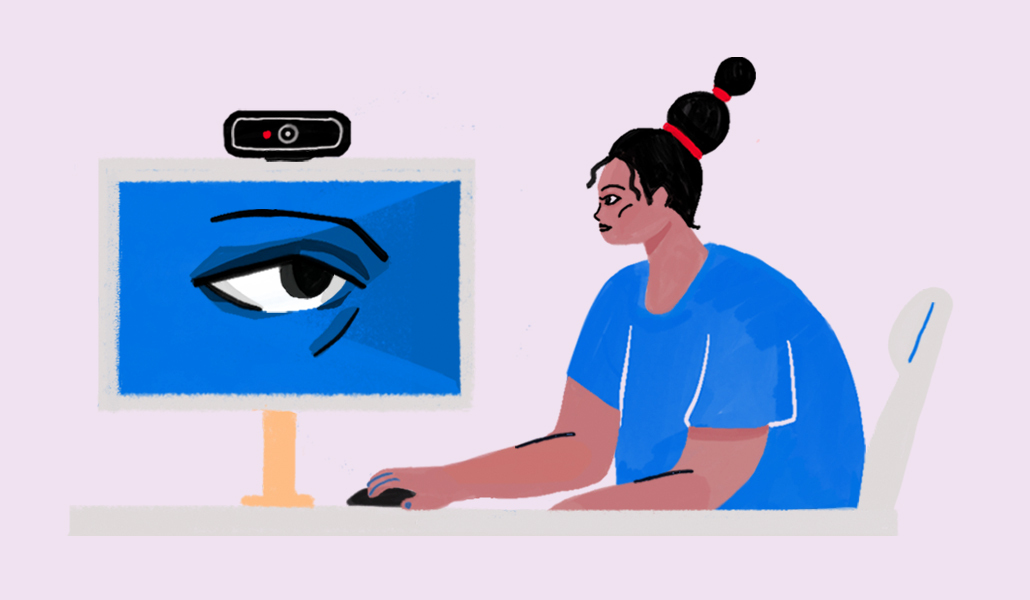How employee monitoring has shifted from creepy to empowering HR teams

A friend giddily informed me a few days ago that she had “found the perfect eraser.” Perplexed as to why something that rubs out pencil marks would evoke such glee, I asked for more details. “This eraser is the ideal weight; I can rest it on the space bar, so the screen stays awake if I leave the desk,” she said. “That way, my manager thinks I’m still being active at my computer.”
Employees who feel they are being observed for no good reason tend to find a way to game the system, argued Brian Kropp, group vp and chief of research for Gartner’s HR practice. “If your employer is trying to screw you by creepily monitoring you, there are various things you can do to screw them over,” he said.
For instance, he revealed that if computer mouse activity is being tracked, then an analog watch can help. If you position the mouse on the watch, then the second hand creates just enough motion to make it still active.
“When you’ve got stupid monitoring strategies, employees will recognize that they’re not designed to help the employer improve the employee experience, and they’re just Big Brother watching,” said Kropp. “Employees are smart and will figure out a way to work around them.”
He recalled a pre-pandemic story at Barclays bank where sensors had been installed on chairs to indicate whether someone was sitting there, or not. “The bankers soon discovered that placing books on the chairs confused the sensors,” said Kropp.
Monitoring is on the rise, though. According to Gartner’s research, around 30% of the medium and large corporate organizations it assesses had tracking systems in place before the pandemic. “Now the percentage is more than 60%,” said Kropp.
Trust and performance issues
This “huge uptick” was largely because employers didn’t trust their staff to work hard when lockdowns necessitated a shift to home working. “A worrying number of employers thought all employees were going to do was watch TV, take naps, and eat pizza,” said Kropp. “Initially, they were concerned about performance.”
However, the tracking tools soon confirmed that most employees were working “just fine” remotely, acknowledged Kropp. Moreover, Gartner data shows on average, people are now working nine unpaid hours extra a week, possibly to justify their jobs (although more hours working doesn’t equal better performance, despite what most people believe). In contrast, before the pandemic, it was six hours.
After employers were reassured that staff members were busy — possibly with the help of erasers and analog watches — they realized that the installed monitoring systems, which came at no small expense, could improve the employee experience. And this reframing has been more agreeable.
Indeed, a survey of 1,000 U.K. workers published in late August by data science company Profusion suggested that 61% of employees are comfortable with their employers monitoring them — but, crucially, only if they can see the data.
Fear of discrimination is the number-one barrier to sharing personal information, followed by worries over data security and information confidentiality.
“Many people believe that better use of data in HR could level the playing field and lead to fairer decision-making,” said Natalie Cramp, CEO of London-based Profusion, of the survey results.
Therefore, most employees are comfortable with HR teams using more advanced analytics “as long as it is transparent and they are given an element of control,” she added. Some 81% of respondents said that data must be made available to employees to enable them to challenge any interpretations.
HR data specialist
Only a tiny minority of companies use HR data to its full potential, according to Cramp. She referenced other research that showed 72% of workers believe that applying data to HR decisions could be better than the practices currently used by their employers. This number rose to 80% for BAME employees and 82% for disabled employees.
“If implemented correctly, a data-driven HR function can play a critical role in improving the well-being of staff, diversity and inclusion initiatives. It can also radically enhance business performance and efficiency,” added Cramp. “There is a clear opportunity for companies to rethink how they approach HR — for example, by making their next HR team hire a data specialist.”
Paul Kelly, head of employment law at Blacks Solicitors in Leeds, in the U.K., pointed out various legal factors to consider before implementing any monitoring policy. These include: What is to be monitored and why? Is the monitoring justified? And can the aim/purpose of the monitoring be achieved by another means?
“If an employer decides that monitoring is still necessary, they should undertake a data privacy impact assessment,” said Kelly. “This is a balancing act to ensure that employees enjoy privacy at work while still protecting the business’s interests.”
Sarah Edwards, a senior employment law solicitor at Howarths, also headquartered in Yorkshire, U.K., stated that the data generated by monitoring should enhance any conversation between HR and the employees. “There should be a genuine two-way discussion about the data and information collected,” she said.
As well as sharing that information, employers must encourage their employees to talk about and challenge how data is interpreted. “This can be done by ensuring that the discussions, while sometimes challenging, are not defensive or confrontational, information should not be presented as a fait accompli, and employers have to listen to explanations that are provided,” added Edwards.
Genuine two-way discussion
Deals site Groupon uses its tracked employee data to highlight where its operational goals can align with its diversity, equity and inclusion program. For example, in 2021 it started gathering data (via an internal dashboard) that tracked the hiring funnel, performance ratings, average compensation ratio, and other key analytics, according to Yemi Akisanya, global head of diversity, equity, and inclusion at Groupon, who resides in the greater Chicago area. “We are leveraging data-driven insights to drive our DEI strategy forward,” he said.
That quantitative data, alongside the qualitative data the company monitors, gives a well-rounded view so it can cultivate a “thriving and vibrant” culture, added Akisanya. “This analysis of people processes across the employee lifecycle allows us to better understand how Groupon attracts and selects employees, develops and retains its existing workforce,” he added Akisanya. For instance, previously underrepresented groups are being identified to improve the range of applicants for advertised positions.
Gartner’s Kropp applauded this approach and urged other businesses to follow Groupon’s lead. “Monitoring data can be incredibly powerful to understand all sorts of things, such as managing employee burnout, staff frustrations, or workflows that might be discriminatory against women, for example,” he said.
Emma Leonis, executive director of HR transformation consultancy LACE Partners, which advises FTSE 250 companies, said it all boils down to the level of trust between employer and employee.
“Monitoring doesn’t have to be about distrust; it can be about understanding, collaboration, engagement, connections or time management, and productivity,” she said. It can also identify systematic issues higher up the chain. For instance, the monitoring data might show a line manager hasn’t communicated with someone for far too long. In that situation, HR can address the problem.
Leonis believes monitoring with adequate access to data and employee feedback loops creates a win-win scenario. “An employee can see it will help them personally, their line manager can communicate and manage more effectively, and the business can operate more efficiently,” she added.

